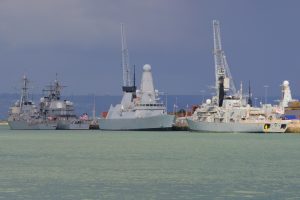Late last week, British Prime Minister Boris Johnson announced a massive new round of funding for the U.K.’s armed forces: a 16.5 billion British pounds boost over the previously agreed levels of funding, representing the biggest increase in defense funding in 30 years.
The funding is heavily directed at futuristic initiatives: artificial intelligence, directed-energy weapons, the Tempest sixth-generation fighter program, and the creation of a British equivalent of the United States’ new Space Force. Meanwhile, more traditional defense programs – like modernizing or replacing Britain’s fleet of increasingly outdated main battle tanks – are likely to miss out.
Of course, all of this comes at a deeply uncertain time for Britain. The pandemic has hit the British economy hard, and with just a month left before the country crashes out of the European Union unless a deal is agreed, its future has rarely been so uncertain. So, the question of whether the U.K. can follow through on this commitment is a genuine one.
Nevertheless, Britain is not alone among European nations in signaling that it intends to show the flag more in Asia. The U.K.’s new aircraft carrier, HMS Queen Elizabeth, will be making its first deployment to the region; the French and Germans have signaled that their navies will do so as well. These gestures will be welcomed by a United States that has been trying with increasing alacrity to build a grand coalition to counter growing Chinese power and influence. But does it mean that Europe will be a player in hard-edged competition in the Pacific?
It is difficult to imagine that outcome. European nations – even acting in concert – are a long way from being able to project and sustain meaningful amounts of combat power that far afield. European militaries are not configured for long-distance combat missions; even the best-equipped continental powers have limited strategic airlift and aerial refueling capacity and no strategic bombers.
At sea, there is slightly more capacity, but only when considering the continent holistically. France and Britain have all the elements of a modern navy, including aircraft carriers (nuclear-powered in France’s case), underway replenishment ships, nuclear-powered attack submarines, and capable frigates and destroyers. Other European nations have some or most of those elements – Italy and Spain operate smaller carriers and most Western European countries have at least some modern surface combatants and submarines.
The problem is numbers. For a navy with one aircraft carrier, a deployment to the Pacific means that for months at a stretch there is absolutely no reserve in case one is needed urgently at home for deterrence or humanitarian relief purposes; furthermore, sending a carrier also necessitates deploying a force of escorts and support ships.
If Europe were a single political entity with a joined-up foreign policy, it might be more straightforward to put together a carrier strike group with assets belonging to different navies in order to share the burden and maintain a continuous, or at least regular, presence. But the mechanism for coordinating such an enterprise would be NATO, which has not agreed to a consensus approach to new out of area operations – and which is a transatlantic, rather than solely European, body. And nothing about the EU’s efforts to develop a unified defense policy suggest that it will be taking on that role in the foreseeable future.
That all said, even if European military assets are a rare and transient presence in the Asia-Pacific, their presence does demonstrate that Europe has interests and aspirations in the region. But even with the advent of a more supportive transatlantic ally in President-elect Joe Biden, it will be difficult for European militaries in Asia to walk the tightrope between supporting shared strategic objectives and demonstrating meaningful strategic autonomy – especially given that, for instance, British carriers will frequently carry U.S. Marine Corps F-35s to increase their combat power.
Absent a global military conflagration, the fundamental limitations on European nations having more than a symbolic forward presence in Asia (or other regions outside Europe’s neighborhood) aren’t going to change because Britain or France has iteratively improved the quality of its multirole fighters or equipped its tanks with a laser defense system. That is not to say that European nations cannot impact the balance of military power in Asia, but rather that the most effective means for doing so will be indirect. That might entail building closer research, development, and joint procurement links with like-minded allies in the region, or by redoubling efforts to build a renewed framework of military transparency and arms control measures, and using a mixture of economic and diplomatic pressure to encourage compliance globally. Most likely, it will require both, along with patience and persistence.

































